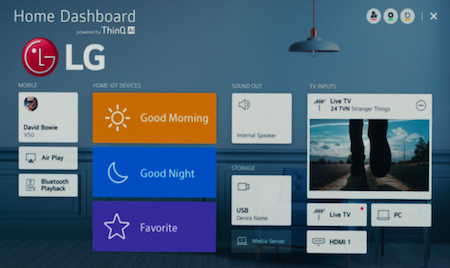The Internet of Things on AWS – Official Blog
“AWS is how”: LG Electronics makes life good with smarter, happier homes
The dream of creating a smart home, where all appliances and electronics could be controlled from a central computer hub, began to take shape in 1965, when a Westinghouse engineer, Jim Sutherland, developed the first home computer, the ECHO IV. Sutherland integrated the ECHO IV into his home’s electronic systems, and he and his family used it to control their clocks, stereo, thermostat, TV, and typewriter. After living with the ECHO IV, Southerland’s wife, Ruth, speculated on the future of home computers, saying, “Wouldn’t it be wonderful if they could provide more time for parents to spend with their children, making every home a happier one?”
We’ve come a long way from using a home computer to set our clocks and thermostats. It’s now common practice for us to turn off home appliances from our mobile phones and use Amazon Alexa to play music in our houses while we’re making dinner. But even these tasks, as remarkable as they would have been to Jim and Ruth Sutherland, are just the tip of the smart home iceberg.
LG Electronics shares Ruth Sutherland’s vision of the smart home as a happier home. With the widest assortment of internet-enabled appliances and one app to control them all, LG not only helps simplify our daily lives—it gives us easy-to-use tools for being more efficient, proactive, and environmentally responsible.

The LG ThinQ platform, which runs on AWS, allows you to control LG ThinQ smart appliances with your voice and cell phone. For LG customers, “control” means more than simply “turning on and turning off.” Using AI, LG ThinQ can learn your preferences to make relevant recommendations and offer tips based on your habits and the status of your devices. For example, ThinQ learns when you tend to get ice from your refrigerator and makes sure that ice is always available at that time of day.
You can also use the ThinQ app to put your smart LG refrigerator in vacation mode—from anywhere you are—to save energy while you’re away from home. When you’re running errands, you can check the app to see how much time is left on your wash cycle and confirm that you can make one more stop before heading home to put your sheets into the dryer. On movie night, as you relax on your sofa, you can use a single voice command to tell ThinQ to adjust your lighting and television, creating the best possible viewing experience. (ThinQ works with Amazon Alexa for voice control, and LG Smart TVs have Alexa built right in.)
Another valuable ThinQ feature is Proactive Customer Care, which helps keep LG appliances performing at their best. ThinQ uses a data lake, built on AWS, to analyze big data and anticipate appliance issues before they arise. Based on usage data gathered from your LG appliances, ThinQ automatically sends you contextual alerts and helpful reports. A notification from your clothes washer, for example, could tell you that you’ve added too much detergent and need to reduce the amount and run a Tub Clean cycle before your next load. And a message from your refrigerator could indicate that it’s time to change the water filter and also provide a filter finder to help you shop.
Over 30% of consumers who’ve received Proactive Customer Care alerts have been able to fix appliance problems on their own, eliminating the need for a service call. Plus, the alert feature helps keep your appliances in “tip top shape,” improving efficiency and durability while saving energy.
How does AWS help LG make homes smarter and more connected? A key word is: “scalability.” AWS provides the flexible, global infrastructure that enables ThinQ to support a growing number of customers, devices, and appliances around the world. For storing, managing, and analyzing the data that brings intelligence to ThinQ, LG relies on AWS secure, resizable, cost-efficient services. These include Amazon Elastic Compute Cloud (Amazon EC2) with the fastest processors in the cloud; Amazon Relational Database Service (Amazon RDS), which is easy to set up, operate, and scale; and Amazon Simple Storage Solution (Amazon S3), offering industry-leading scalability, data availability, and performance.

Powering smart homes and creating personalized experiences depends on collecting and exchanging appliance data, and LG gets help from AWS in this area as well. The company employs AWS IoT services, which are easy to use and bring together data management and rich analytics. AWS IoT services integrate with other AWS services, allowing LG to build complete solutions. Plus, AWS IoT services scale to billions of devices and trillions of messages, helping ensure that LG can keep innovating to bring more intelligence—and more happiness—to more homes around the world.
You can see how LG makes homes smarter and happier in the new “AWS is how” ad campaign.
Learn more about how AWS helps customers build smart products and services in the cloud. And check out the list of LG products that were honored with 2021 CES® Innovation Awards and the LG press event at CES 2020.